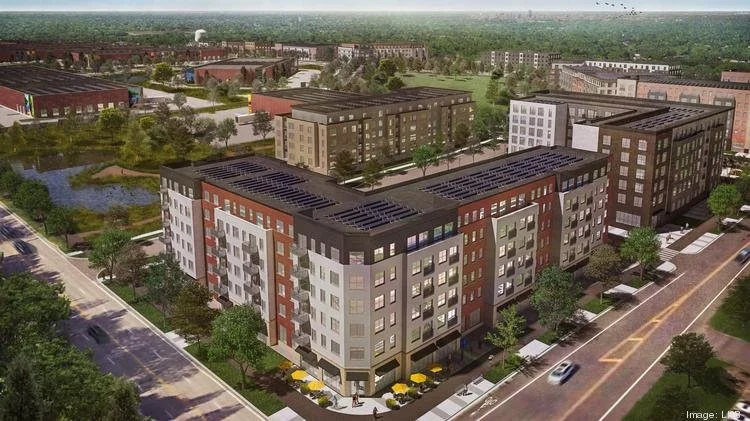Minneapolis company with St. Paul history named master developer at old Hillcrest Golf Course site
[Originally Published by Twin Cities Pioneer Press, Written by Frederick Melo: View Source]
The St. Paul Port Authority announced April 25, 2023 that Sherman Associates will be the master residential developer for The Heights, the more than 112 acres of land spanning the former Hillcrest Golf Course. Sherman intends to bring 1,000 housing units to the site, including five apartment buildings spanning a mix of affordable and market-rate units. Twin Cities Habitat for Humanity would add another 150 homeownership units, from single-family to fourplexes. Up to 1,000 jobs are anticipated on site, with Xcel Energy building a new east metro operations center. (Courtesy of the St. Paul Port Authority)
Sherman Associates will work with JO Companies and Twin Cities Habitat for Humanity as residential developers of The Heights.
Over the next five-to-seven years, a Minneapolis developer with a long history in St. Paul will oversee the creation of 1,000 new mixed-income residences at The Heights, the 112-acre future development formerly home to the Hillcrest Golf Course.
The St. Paul Port Authority, which acquired the defunct country club and its golf course in 2019, announced that Sherman Associates will be the master developer at The Heights, working hand in hand with Johnny Opara and the JO Companies, as well as Twin Cities Habitat for Humanity on a wide range of rental and homeownership options.
Plans include 150 Habitat for Humanity affordable homeownership opportunities, ranging from single-family homes to fourplexes — the largest single-site project that Twin Cities Habitat has ever embarked upon, according to officials with the St. Paul-based nonprofit.
At 112 acres, the former Hillcrest grounds span almost as much land as Highland Bridge, the development sprouting where the Twin Cities Ford manufacturing plant once stood in Highland Park.
“Find me another city able to say … (they’re developing) not one but two 100-acre sites from the ground up,” said St. Paul Mayor Melvin Carter, during the celebratory unveiling Tuesday of Sherman as the master developer. A media event was held at Port Authority offices in downtown Treasure Island Center on Wabasha Street.
Four to five apartment buildings planned
Chris Sherman, president of Sherman Associates, said plans are still gelling and will depend in part on financing, but the general goal is to have Sherman develop four of the five apartment buildings to be located off Larpenteur Avenue and McKnight Road and down Winthrop Street to Hoyt Avenue.
Sherman said he hopes to close on financing for the first two buildings, each likely involving 175 rental units, in mid-to-late 2024, with construction wrapping in the spring of 2026. One building would likely consist of workforce housing — with units aimed at households earning between 60% and 120% of area median income — and another could be backed by low-income housing tax credits, which have their own income requirements.
Opara said he envisioned developing a single building, spanning between 110 to 230 units, though discussions over the type of affordable housing and where on the site his project would be located were less far along. “It could be workforce housing, it could be senior housing,” he said.
Habitat would likely begin developing affordable housing for homeowners in 2025, once the multi-family apartments were underway, said Sharon Sayles Belton, past president of the board of Twin Cities Habitat for Humanity, and Cathy Lawrence, Habitat’s chief development officer.
Up ahead: State bonding, job training
Port Authority President and Chief Executive Officer Todd Hurley said denser housing will be clustered in the apartment buildings toward the north end of the site, with the Habitat for Humanity homes running up and down the southwest edges of the property along Winthrop Street.
Working with state Sens. Sandy Pappas and Foung Hawj, as well as state Reps. Liz Lee and Jay Xiong, the Port Authority hopes to obtain $13 million in state bond funding to complete “the last piece of the public infrastructure budget puzzle,” Hurley said. Together with land sales and Port Authority funds, state bonding would bring total spending on infrastructure, environmental clean-up and other site work to $50.5 million.
Officials said prospects for commercial development that could bring 1,000 jobs to the city’s East Side also look promising, which would be a boon for the working class neighborhoods of the East Side, one of the most ethnically diverse corners of the Twin Cities.
The Port Authority on Tuesday agreed to sell 20 acres of land in the lower center of the former golf course to Xcel Energy for $6 million, allowing the energy utility to move its Rice Street operations center to the East Side and build a modern new facility that will be twice the size. Plans call for electric car charging stations for a vehicular fleet expected to go all-electric by 2030.

